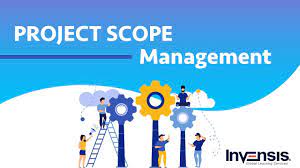Tag Archives: tables
Project Scope Management. 2022 Best

This assignment involves writing a literature Review for Project Scope Management. The typical length of a paper for proceedings is 6-12 pages, including tables, charts, and references. The main body of the paper should be numbered in consecutive order
Project Scope Management.
Final paper (aggregation of all discussion board assignments): The final paper should be the final product of your work throughout the term and the results of your weekly discussions. The core content of the final paper is the results of your readings and the findings you have devised. It is okay to reuse some of your posts in your final paper as you see fit. At a minimum, in your Results and Discussion section of your final paper, try to address the following questions: · What are some of the possible answers to your questions? · What are some of the important findings you expect from your investigation?
Project Scope Management.
What is the practical significance of your predicted findings? · What is/are the contribution/s of your findings to what we know or do not know about your topic? Your submission should follow the format of a research paper and should be ready for sharing at a symposium, seminar, workshops, or conference. The typical length of a paper for proceedings is 6-12 pages, including tables, charts, and references. The main body of the paper should be numbered in consecutive order: ABSTRACT I. INTRODUCTION II. METHOD III. RESULTS AND DISCUSSION
Project Scope Management.
IV. CONCLUSION REFERENCES Here is an example of a Literature Review research paper: Denicol, J., Davies, A., & Krystallis, I. (2020). What Are the Causes and Cures of Poor Megaproject Performance? A Systematic Literature Review and Research Agenda. Project Management Journal, 51(3), 328–345. https://doi.org/10.1177/8756972819896113 (Links to an external site.) https://journals.sagepub.com/doi/10.1177/8756972819896113 (Links to an external site.) You can use this example as a reference to know how to design and write your final paper. https://youtu.be/VUUa5iU3Gwk
Additional Files
Active learning by incorporating technology – 2022 Best

The goal of this assignment is to focus on active learning by incorporating technology and approaching mathematics from an applied standpoint. This project uses Excel to create and interpret mathematical model
Active learning by incorporating technology
Firstly, the goal of this assignment is to focus on active learning by incorporating technology and approaching mathematics from an applied standpoint. Secondly, this project uses Excel to create and interpret mathematical models, solve problems with accurate calculations, analyze assumptions and solutions, and construct sound conclusions. Thirdly, the result of the project provides concrete evidence of your quantitative reasoning skills. The project is due by the end of the workshop. Fourthly, upon successful completion of the course material, you will be able to…. Interpret mathematical information from various models (e.g. graphs, tables, equations, words, functions, figures).
Active learning by incorporating technology
Create mathematical models symbolically, visually, and/or numerically. Apply algebraic, geometric and statistical methods to solve problems. Demonstrate understanding of the mathematical methods with accurate calculations. Also, analyze the assumptions and solutions to the mathematical problems. Construct sound conclusions by synthesizing the mathematical models, methods, and solutions. Gen Ed Outcomes Quantitative Literacy – Students can solve quantitative problems from a variety of authentic contexts presented in a variety of formats. Interpretation – Ability to explain information presented in mathematical forms (e.g., equations, graphs, diagrams, tables, words). https://youtu.be/hza-EAff5Qk
Active learning by incorporating technology
Representation – Ability to convert relevant information into various mathematical forms (e.g., equations, graphs, diagrams, tables, words). Calculation -Application/Analysis – Ability to make judgments and draw appropriate conclusions based on the quantitative analysis of data, while recognizing the limits of this analysis. Assumptions – Ability to make and evaluate important assumptions in estimation, modeling, and data analysis.
Active learning by incorporating technology
Communication – Expressing quantitative evidence in support of the argument or purpose of the work (in terms of what evidence is used and how it is formatted, presented, and contextualized). This table shows the results for 13 students on a 16 question multiple-choice exam. A “1” means the student got the question correct, and a “0” means the student did not get the question correct. Copy the table into an Excel spreadsheet and make sure to save it to your computer. ( the table is in the Excel file attached) Instructions 1. Complete the Exam Scores project.






